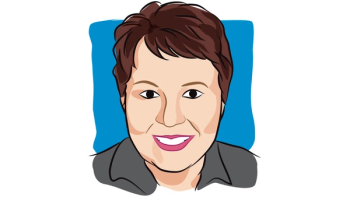
Educated Patient® MPN Summit Myelofibrosis Second-Line Treatment and Beyond Presentation: November 19, 2022
Watch Dr. Andrew Kuykendall, from the Mofitt Cancer Center, discuss second-line treatments and beyond for patients with myelofibrosis during the CURE® Educated Patient® MPN Summit.
Episodes in this series

Patients with myelofibrosis (a type of myeloproliferative neoplasm) who experience disease progression or unacceptable side effects on frontline therapy tend to do better when they move on to second- or third-line therapy (be it salvage treatment or stem cell transplant), compared to those who stop therapy after their first treatment stops working, according to research.
As such, it is important that patients and clinicians work together to choose an optimal second-line treatment, explained Dr. Andrew Kuykendall, an assistant member in the Department of Malignant Hematology at Moffitt Cancer Center.
“We know that there is benefit in giving some additional therapy to patients who can tolerate it, in the hopes of mitigating some aspects of the disease and hopefully improving survival,” Kuykendall said during a presentation at the CURE® Educated Patient® MPN Summit.
Kuykendall explained that Jakafi (ruxolitinib) is commonly used as frontline treatment for myelofibrosis, as the JAK inhibitor has proven to improve outcomes and side effect profiles for patients with the disease. However, researchers and clinicians are working to determine when the best time is to take patients off Jakafi and put them on another regimen.
“We’re trying to get a little bit better at identifying patients who may benefit from an earlier change in therapy or an earlier switch,” Kuykendall said. “We certainly don’t want to run into the position where we’re treating patients continuously with (Jakafi) and they’re not benefitting, and we keep them on for a long period of time. And then, by the time they switch or move to something else, we don’t have too many (treatment) options.”
Kuykendall cited an Italian study that analyzed outcomes of patients on Jakafi with poor prognoses. The researchers found three factors that correlated with worse survival:
- Insufficient dose of Jakafi (doses less than 20 mg twice per day)
- Transfusion dependence
- Poor spleen response
“On one hand, it says we should be trying to get adequate doses of Jakafi to be able to get these spleen responses and really, we should be adding on supportive therapies to reduce the need for transfusions or consider alternative therapies there,” he said. “But it also says in those patients who can’t safely reach high doses of (Jakafi), or who aren’t having a good spleen response or require a lot of transfusions, maybe we need to consider another option.”
If patients stop frontline therapy due to disease progression, there are a few options that can be considered, Kuykendall said.
For patients with accelerated or blast phase disease, which progresses to acute myeloid leukemia, drug options will often include a hypomethylating agent such as decitabine with or without Jakafi or another JAK inhibitor, or intensive chemotherapy for patients who are young, fit and eligible to eventually go on to transplant.
For patients with progressive disease characterized by spleen inflammation that continues to grow despite therapy — known as constitutional disease — patients and providers should consider switching to another JAK inhibitor, Kuykendall noted.
If patients need to stop Jakafi, due to side effects — most commonly cytopenia or low blood counts — they may be eligible to take Vonjo (pacritinib) or Danazol. Clinicians may also sometimes use Revlimid (lenalidomide) or thalidomide in this setting.
As research in this field continues, Kuykendall predicts that second-line treatment for myelofibrosis will continue to become more personalized.
“We may be in a situation where we can really individualize therapy for specific patients, depending on why you need to move to second-line therapy,” he said. “You might have a number of options that we can then highlight and figure out what makes the most sense moving forward, and that’s certainly an exciting area that we can get to hopefully sooner rather than later.”
For more news on cancer updates, research and education, don’t forget to














